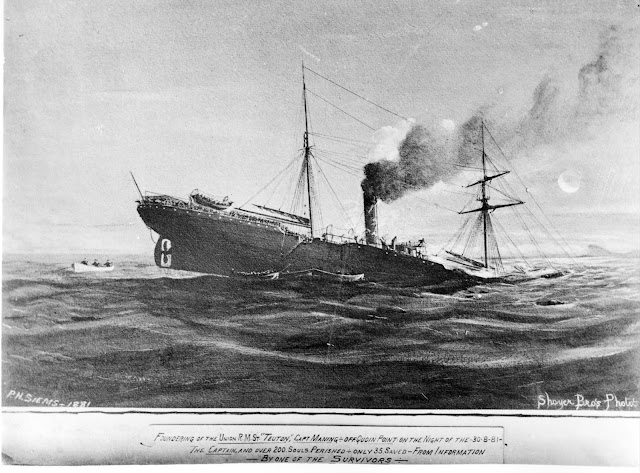SAHRA Maritime and Underwater Cultural Heritage
August 30:
“This day in our shipwreck and aeronautical wreck history”
1819: Good Hope, this wooden-hulled brig wrecked at the Baakens River mouth in Port Elizabeth in the Eastern Cape in the same south-easterly gale that claimed the Thomas, Uitenhage Packet, and the Winifred & Maria the previous day.
1845: Martha, this wooden-hulled brig wrecked during a south-easterly gale in Mossel Bay in the Western Cape. It entered Mossel Bay because it had lost its boats and was running low on provisions. Its cargo of mail was saved.
1868: Ambleside, this wooden-hulled barque wrecked in a south easterly gale just north of the Mzimkhulu River mouth in Port Shepstone in KwaZulu-Natal. Her cargo of cotton and linseed littered the beach and was sold at auction for a considerable profit.
1881: Teuton, this iron-hulled steam-powered ship struck a chartered rock near Quoin Point in the Western Cape and foundered shortly afterwards near Danger Point in the Western Cape. It was en-route from Table Bay to Algoa Bay when it found itself about 1.6 km off course with the Cape Agulhas lighthouse in sight at 19:00, striking a chartered rock off Quoin Point. The captain inspected the damage and felt confident it would make the journey back to Simons Town for repairs. The crew and passengers manned the pumps and started throwing cargo overboard to lighten it. As a precaution, the lifeboats were also readied.
At about 22:00, off Danger Point, the pumps could no longer cope with the incoming water and its stern section raised with the propellor no longer in the water. The first boat was launched in an orderly fashion and filled with children and women and whilst the second boat and third boats were being launched, the Teuton suddenly flipped over, bow first, and sank within minutes. The first boat swamped as a result with only 27 people managing to reach the second and third boats. The two lifeboats made it into Simon's Town and a day later a third lifeboat with only nine souls on board arrived in Table Bay, having struggled to get into False Bay.
It was said at the time that a Miss Rose/Ross provided the clearest account of what had occurred from the perspective of the passengers. She was a teenager and the only woman to have survived the event and in the 2021 wrecking anniversary post, a user commented that she was her great grandmother and was adopted by a rescuer with her name changing to Elizabeth Maxwell. The other 236 souls that were on board the Teuton were lost and the event has gone down as one of the worst maritime disasters from a single ship sinking in South African waters.
1888: A south easterly gale blew into in Port Elizabeth in the Eastern Cape and created havoc in Algoa Bay. Between 8-10 vessels were wrecked or grounded (historical sources vary) but out of all of them only one life was lost during the wrecking and a second, shortly thereafter, possibly linked to a wrecking.
• Andreas Riis, this Norwegian barque wrecked whilst discharging its cargo of coal.
• Burgomeester (possibly Burgomeester Schorer), this schooner ran aground after discharging its cargo. It was possibly refloated.
• C Boschetto, this Italian barque was put in for repairs and was lost after its cables parted. A local photographer, Mr William Alcock, was called to assist the rocket brigade during its rescue as his ‘limelight apparatus’ was needed to illuminate the scene.
• Dorothea, this German brig was lost shortly after having discharged its general cargo and 4,000 cases of dynamite.
• Drei Emmas, this Belgian barque was lost whilst discharging its cargo of coal.
• Elizabeth Stevens, this British barque was lost and was carrying a cargo of wheat.
• Jane Harvey, this British Barque was lost whilst loading its cargo of mohair.
• Lada, this Austrian barque wrecked after discharging a cargo of rails, and although no lives were lost during the wrecking, the captain died from heart failure shortly thereafter and there is speculation that the loss of the Lada resulted in this.
• Natal, this Swedish schooner wrecked after its cables parted and its cargo had been discharged.
• Wolseley, this British iron barque wrecked when its cables parted whilst discharging its cargo. One crew member perished.
1888: Rosebud, this wooden-hulled schooner wrecked during a south-easterly gale on Pansy Beach in Mossel Bay in the Western Cape. After its wrecking, the beach was renamed Rosebud Beach, but is sometimes still called Pansy Beach. During spring low tides, some of the wreck protrudes out of the sand.
1908: Ticino, this iron-hulled collier wrecked 8 km south of Port Nolloth in the Northern Cape in heavy seas after the bar in Port Nolloth became impassable and it lost two of its anchors. It broke up within an hour after wrecking.
Aerial photo/video service/inquiries: info@traveltonamibia.com

No comments:
Post a Comment